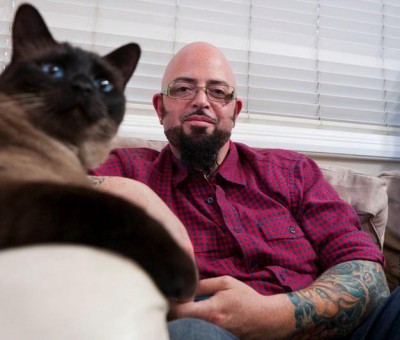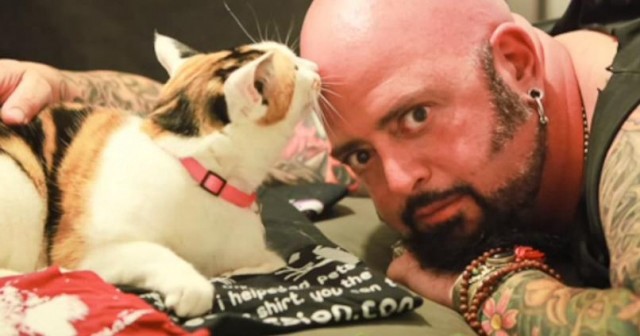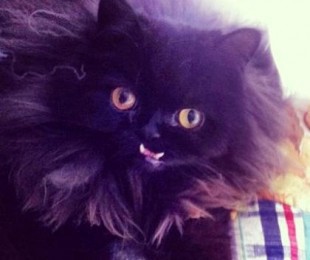Cat Man Jackson Galaxy On Dead Cats, Internet Celebrity Cats And Being A Cat Freak
by Jenni Miller

Cats are weird little creatures that we invite into our homes, even though they are armed with sharp bits that can rend our skin and poke out our eyeballs. They crap in boxes of sand, and they shed fur everywhere unless they’re hairless, in which case you’ve got a whole other host of problems to deal with. They eat disgustingly stinky food, occasionally puke up hairballs, and go through phases of inexplicable 5 a.m. yowling. It’s no wonder cat lovers are so defensive and neurotic and absolutely obsessed. Perhaps we have Stockholm syndrome.
In a world where people watch TV shows dedicated to legit DSM diagnoses, it was a no-brainer to give cat people a show just for us. In 2011, Animal Planet unleashed “My Cat From Hell” on the world, 60 minutes (with a few commercial interruptions) of feline dysfunction and misbehavior, nutty humans, and one cat behaviorist hoping to unite them all. It’s not clear if Jackson Galaxy is an emissary from the cat world to ours or vice versa, but his particular brand of “cat mojo” is rising. A lifelong musician, Jackson Galaxy discovered his talent with cats in particular while working for the Humane Society of Boulder Valley in Colorado; his slow rise to success (and, perhaps not so incidentally, sobriety) is at the heart of his memoir Cat Daddy: What the World’s Most Incorrigible Cat Taught Me About Life, Love, and Coming Clean.
The elevator pitch for Jackson Galaxy writes itself: He’s a tall, bald guy with oversized glasses and fully sleeved arms, pierced ears, fancy sideburns, and a goatee that gives Anthrax’s Scott Ian a run for his money. Whether it’s a flourish added by the show producers or not, Jackson Galaxy drives a pastel pink ’57 Lincoln and often wears shirts embroidered with “Cat Daddy” on the breast pocket. He carries his cat toys in a guitar case. And he loves cats. Like, he loooooves them.
It’s not uncommon to see Jackson Galaxy get choked up on his show, or get down on the floor and take his glasses off so he can get eye to eye with a cat. (Pro tip: The earpieces of your glasses have your scent on them, so they can be used as a way to introduce yourself without being too intrusive.) Sure, it would be great to get past a world where it’s not important for heterosexual men to be reassured of their masculinity despite their love of cats — or have it associated with any sort of gendered behavior or sexual preference — but in the meantime, here’s a bearish tattooed guy who loves little kitties.
Jackson and I caught up on a busy day last week, in between interviews, during a car ride to his chat at the Strand with Gwen Cooper, and after being stopped by a police officer on a horse who was a fan. Later that night, in the very warm loft space above the Strand, he held court with cat lovers of all ages who wanted to know if he was vegan (yes), about his pets (three cats and a dog), and what happened to a cat named Lita. (Lita’s human Ryann was dating this super jerk named Derek whose own cat, Buddy, was bullying Lita. Her only recourse was fear-barfing and hiding until Ryann and Derek broke up, something Jackson discovered on his follow-up visit. Note: it’s not clear if Lita was named after Lita Ford, but we can only hope. Hey Derek: if you’re reading this, you were booed by an entire room of strangers.)
Let’s talk about getting recognized on the street. What’s that about?
It’s weird because it’s really kind of hit a different space in the past couple of weeks only…. For a little while, the show would be on the air, and then I would be in the supermarket and get stopped, and then the show would be on hiatus and I was private Jackson again, but now it’s just not happening. It’s great, though. I think it’s fantastic. I think every day that I get reminded that more people have cats, live with cats, and see me as a representative of that life, I’m flattered. I think it’s amazing.
How did you go about writing a memoir so soon after losing Benny? It’s so difficult to write about grief.
Yeah, it is. The book took shape during his last couple of weeks, and I write about it, where, because I have that make-up of being the fixer — and it was being almost thrown in my face. I was being taunted with it, you know? And it was torturing me. And the whole thing that I knew was, since I was a child, was to write in order to make sense of emotions that were too big. And that’s all I was doing. I didn’t set out to write a book. I swear, all I wanted to do was pass the time with him, you know, honor our relationship. That’s all I was trying to do.
It became a lot harder — it became ridiculously hard — when I was actually finishing the book. When Joel [Derfner] and I were sitting in my mom’s living room, and we were finishing those couple of scenes, and he’s just sitting there with headphones on, he’s editing, and I just keep handing him pages, and I am a blubbering, wailing mess. I think the hardest thing about the process was reliving it, was never ever having a period to put on the grieving process, but the beautiful thing about that, I gotta tell you, is I always did grief counseling, you know, back in the shelter and now of course, but there’s a different level of connection that I have with people who have had animals in their lives, because part of that joy is that intense sorrow. I feel uniquely qualified now to talk about it because I aired it so completely.
I totally would tell anyone, anyone who wants to know, that losing my first cat was easily as difficult as my father’s death. Like, easily.
I think it’s impressive because there’s — to be able to say it was as hard, if not harder than losing my dad, but that’s because we don’t have anything mixed up in the pure emotion of grief, that we have in a relationship with an animal. There’s no “I should have said this,” or “Unfortunately, they said this to me and that stuck with me and sent me to therapy for 20 years,” none of that, you know? All there is is pure joy, pure love, unconditional, and then that level of loss. And it really is, it’s a feeling unto itself, but I think one of the beautiful benefits of writing the book is that when I meet people now, when I am doing grief counseling, I can point to that. I can point to that section in the book, and the epilogue which I think is equally important because it’s coming out the other side, and show that it is something to walk through and not something to get stuck in, because we lose a love of adopters that way. One huge loss and, like, “No, no. I’m never going back there again.” So, to me, it was like my own how-to manual of walking through grief, but it doesn’t go away.

Lighter subject, because I don’t just want to talk to you all about my dead father and my dead cat. How do you deal with missing your pets when you’re on these long book tours?
It sucks, there’s no two ways about it. It’s just completely, it’s not a solvable equation, to be on the road and to miss your animals so much, and there’s even more guilt in that I really miss my dog a lot. I make it a point at every book stop along the way to hold up my phone and show that my dog is my screensaver, and that’s just because I do want to prove that point that you can be both a dog and cat person. But also I have this feeling like dogs are more of a — because they depend on you so much, and they depend emotionally, I think, a little more than cats do — you feel like more like you’ve left a child at home. Rudy is not home alone, so that’s a good thing, but it’s really hard. The upside is that everywhere I go, I am bombarded with peoples’ pictures of their cats and dogs, and I love that, and it eases it, for sure.

LIL BUB

Princess Monster Truck
What do you think of cat celebrities, like Lil Bub? There’s a new cat named Princess Monster Truck who’s a rescue, who’s this amazing-looking Persian with a snaggletooth. They’re really kind of magical. What do you think?
I don’t know. I honestly… Like, the whole cat Internet thing is — and I can pretty much spin a theory on just about anything — that one is so beyond me, that I just don’t…. Whether they’re jumping in the boxes, playing keyboard, playing, you know, hanging from the ceiling, it’s just one of the weirdest things to me, and I tell myself, hey, as long as it elevates cats, then I’m down. But personally? I don’t know. Like the Grumpy Cat thing? That lands firmly in the land of “Go Figure.” I can’t for a second understand how Grumpy Cat has six bazillion Twitter followers. It just doesn’t make sense to me.
I think what’s cool about Lil Bub is she was just born that way, and her “dude,” whenever they appear anywhere, it’s at a shelter. I went as a civilian and not a journalist to go meet Lil Bub, and you had to bring food or donate money to this wonderful little shelter. And she was like a little Buddha. It was crazy.
No, it’s great to see. Like I said, as long as it elevates the cats, as long as it’s — when we do things that bring attention to them and brings attention to the shelter cats, then I’m down. I was down at South by Southwest, and Grumpy Cat was down there, and it was like, people waiting in line for 12 hours to, like, touch the paw of Grumpy Cat. And I actually, I wasn’t crazy about it. I really wasn’t. I don’t like putting cats on display, only because who asked them? [laughs] Who asked Grumpy Cat or Tardar Sauce or whatever if Tardar Sauce actually wanted to be there or not? And sit on a cushion all day sponsored by whatever — that got me a little bit.
Now that you’re doing tons of press and being swamped with people on the street, how do you deal with anxiety naturally?
I gotta be honest with you; this doesn’t make me anxious. Like, even in the least. Life makes me anxious. Paying bills makes me anxious, or trying to figure out what I’m going to have for lunch makes me anxious, but this was something — and I think in Cat Daddy there’s a very clear social chronology of how this was okay from the beginning, that being onstage was something that more natural to me, always, than anything else. I feel real blessed in that way because I don’t feel overwhelmed by it, I don’t feel it’s changing me in any way because I was prepared.
I have a lot of friends who are visibly modified — me not so much — but I know that calls a lot of unwanted attention, maybe people reconsider how professional you are or whatever, and in your book at one point you discuss taking out your piercings and so on. I was wondering at what point did you come into your own and say, this is me. I’m gonna have my awesome vivid beautiful sleeves and all of the rest, and fuck it.
I mean honestly, that whole time of hiding my stuff was totally regrettable. I have always been a freak since I was a kid. I was always a freak, and there was always that part of me, though, that was like, hey, what are you staring at? You know what I mean? [laughs] You make your bed, you sleep in it. No, I couldn’t be more at ease at this point, at least with that part of myself, because I also seem to represent a subculture, at this point. Every signing, I am pausing about 10 times to take a picture of just absolutely rad cat tattoos. And it’s like, we call them “cattoos,” and we’re all psyched about them. I have signed piercings. It’s a beautiful thing. I honestly love the fact that we are part of a generation that says, oh, you think you know what a cat person looks like? Oh, I see.
It’s beautiful, because also, by exploding these stereotypes, at the end of the day, it all looks the same, which is more cats go home. More guys who look like me go, oh, cats are cool, okay. Cats go home. We all have to adopt two or three of them. We all do, in order to end the killing. I am so honored to be the freakish spokesperson, I couldn’t even tell you.
It’s also cool because it shows a professional person on a successful television show with a book doing these gigs, being successful, and also having really lovely tattoos, as opposed to a lot of small-minded people who think….
Yeah, it’s amazing. And you know what? I have always been cool with [it], except for that one period in my life where I was like, oh my God, I have to make a living at this. But other than that, I’ve always — I’ve asked people to judge me. I’ve always asked for it, because you know, I got that in an interview this morning — “Why do you look like this?” Part of it subconsciously has got to be, it’s like a head cleaner, you know what I mean? As soon as you realize that you can’t pass judgment, that you can’t put me in a box, then okay, let’s get on to the real stuff.
Jenni Miller has been writing for fun and profit since the age of six and can be found bathing in the glow of the silver screen, playing video games, inhaling books, and examining pop culture with a savvy, feminist eye for a variety of publications. This interview was lightly edited.
Julia Holter, "World"
https://www.youtube.com/watch?v=BmT7GKPsxto
It has been pretty amazing to watch the evolution of Julia Holter’s work over the last, what has it been, only two years? I cannot believe she will ever reach a point where she is “mainstream,” but I can certainly see her pulling whatever “mainstream” is closer to what she does. Anyway, she’s got a new album coming in August and this is on it.
Descending Bovine Momentum Clarified
“A letter to the editor on May 5, about ‘Red Doc>,’ a book of poetry by Anne Carson with some lines that refer to the velocity of a falling cow, misapplied the notion of a constant acceleration due to gravity near the Earth’s surface. The rate, 9.8 meters/second2, refers to the increase of velocity per second, not the velocity itself.”
Woman Puts Things On Feet At Work
NO RT @irincarmon: Noooooo RT @annielowrey: I can’t even. washingtonpost.com/blogs/the-fix/…”
— Aminatou Sow (@aminatou) May 27, 2013
If you were vacationing super-hard this weekend, you may not have heard a thousand FEMINISTS screaming all at once, and therefore missed the story of the year. It starts like this: “It may say more about Washington than White House counsel Kathryn Ruemmler that she’s known in the West Wing for her fabulous shoes.”
Here is a longer response than “nooooo.”
Sitting Is The New Thing That Is The New Smoking
“The chair is out to kill us,” and even exercise is no help, says Science.
Ditch The Herd With Corona Light
by Awl Sponsors
“Adios,” says Sully the sheep, fed up with just being another face in a crowd. There’s nothing cool about being one of the herd, or drinking the typical light beer. Corona Light invites you to ‘ditch the herd’ and trade up to a refreshing, premium change. Non-conformism never tasted so good.
Bike Share Not Disastery Enough For Local Tab

Sadly for the New York Post — a paper whose hatred of bikes and those who use them is so beyond all sense of reason or proportion that one is forced to believe it is actually genuine rather than something affected to sell papers or directed by the whims of its owner — no one died in yesterday’s rollout of the new bank bike share program, so instead the seekers of truth who staff that periodical were forced to focus on the minor malfunctions attendant to any new enterprise. You will be shocked to learn that they were also able to find a few New Yorkers — a group usually united by its reticence to discuss personal inconveniences lest it be seen as griping — willing to register their displeasure, although none was as delightful a complainant as the “adjunct English professor at Columbia University who lives in SoHo” dug up by sister paper the Wall Street Journal, whose residential proximity to one of the racks has induced such terror that, she reveals, “I have horrors of seeing someone die from my apartment window.” Nobody tell her about what cars do to pedestrians, okay? Anyway, did you ride a bike/see someone die/walk by one of the 9 million racks in the city this weekend? Tell us in the comments!
Welcome Back
Among tonight’s brave choices: Emily Gould and Bennett Madison at McNally Jackson, or Andrew Sullivan and Dan Savage at the New York Public Library. Prepare for storms either way!
Saving Summer's Trashiest Cocktail: Make Way for the $21 Long Island Ice Tea
by Ben Crair

Eleven Madison Park is either a very good restaurant or the absolute best restaurant in New York City. It depends on whom you ask. But don’t ask me: I’ve only had a drink at Eleven Madison Park, and that drink was a Long Island Iced Tea. It came in a highball with four perfect cubes of ice and a wedge of lemon. It cost sixteen dollars and tasted just like college.
“I haven’t served one of these in six months,” the bartender told me. Like his peers at the other fine New York bars and restaurants where I have lately been ordering Long Island Iced Teas, he had repeated my order back to me: “Long Island Iced Tea?” His neck muscles tightened, giving bloom to a gritted smile. That smile said: “The customer is always right.” I confirmed the order, and he obligingly prepared it. Later, when we struck up a conversation, he told me the last person to order a Long Island Iced Tea at Eleven Madison Park “was definitely not from New York.”
There is no cocktail as maligned as the Long Island Iced Tea. Equal parts vodka, gin, white rum, white tequila, and triple sec, plus sour mix and a splash of coke — its reputation is basically on par with rufinol. “I first started taking cocktails seriously, if that’s the word I want,” David Wondrich, the cocktail writer for Esquire, once said, “when I realized that I couldn’t in all good conscience step up to the bar at a place called ‘The Mudd Club’ and order something called a ‘Long Island Iced Tea.’”
Wondrich’s snobbery is common in New York. “Long Island Iced Tea drinkers need not apply,” begins the Zagat entry for the Pegu Club in SoHo. Like everything else, cocktail menus have grown decadent and incomprehensible. Why drink a Manhattan, when you can drink a Manhattan that’s been aged in an oak barrel for six weeks? If you like old fashioneds, then wait until you try the smoked old fashioned. Before you know it, you’re drinking an Applethy: “horseradish-infused Absolut vodka mixed with green apple juice, carbonated, and served on draft with a slice of apple that has been sliced on a meat slicer and compressed in a vacuum bag with Campari.”
What you definitely won’t be drinking is a Long Island Iced Tea. “It’s traditionally ordered by people looking to get inebriated in a hurry,” said Brian Van Flandern, who served exactly three Long Island Iced Teas in his three years as the “head mixologist” at Per Se, where they cost twenty-five dollars apiece. “They don’t know what else to order.” For a Long Island Iced Tea, you head to Coyote Ugly. “If you’re at a nice bar, you order a widow’s kiss,” the bartender at Eleven Madison Park recommended.
I started ordering Long Island Iced Teas because, secretly, I’ve always believed it to be a more interesting drink than people credit. American cocktails came of age during Prohibition, when the booze was so bad you had to mix it with something else — sugar, citrus, egg — just to make it potable. The Long Island Iced Tea, with so many awful ingredients, stays true to this original cocktail spirit. It doesn’t taste good exactly, but that it’s drinkable at all is pure alchemy. Maybe it would benefit from a new habitat, a better upbringing.
“Long Island Iced Tea!” said Luis, the bartender at Bemelmans Bar, with a hubba-hubba cadence. His enthusiasm was surprising, given the setting: Bemelmans, which is tucked in the first floor of the Carlyle, is the epitome of uptown elegance, and named after the children’s illustrator who hand-painted its wallpaper. Ludwig Bemelmans’ paintbrush couldn’t reach the ceiling, so they gilded it with gold leaf instead. The jazz music at Bemelmans is live, and the bartenders wear red jackets, as though going on a fox hunt for after work.
Ten years earlier, a New York Times reporter ordered a Long Island Iced Tea from Luis, and his recipe hadn’t changed: He used the juice of half a lime and half a lemon in place of sour mix, shook it like a maraca, then topped it off with Coke. (“If you shake it with the Coca-Cola, it’s going to splat,” the Times quoted Luis.) The lime juice was a novel and refreshing addition. Price: twenty-one dollars.
Luis admitted he hadn’t served a Long Island Iced Tea in awhile, but said they were popular at Bemelmans in the nineties. Then cocktail culture took over, and everyone started ordering Manhattans and martinis and widow’s kisses. This was surprising, since Bemelmans has always been classy and the Long Island Iced Tea has always been anything but. “It’s a college drink, or a first-timers drink,” said Bob Butt, the man who invented the Long Island Iced Tea at the Oak Beach Inn — on Long Island — in 1972. Butt now lives in Florida and runs the Official Website of the Original Long Island Iced Tea. “It’s amazing to me how many hits I get,” he said. “I probably get forty hits a day.”
A good Long Island Iced Tea, Butt said, is stealthy: “When it’s made right, you can’t tell how strong it is.” He invented the drink like a child at a soda fountain, taking all the clear liquors at his bar station and mixing them together. When a colleague said it tasted a bit like tea, Butt added a splash of Coke and said, “Now it looks like tea, too.” In no time, the Oak Beach Inn was mixing Long Island Iced Teas in the basement and serving them on tap. 41 years later, he got his credit due, when PBS featured him on its “Inventor” series.
“In those days there were no drunk charges for anybody, you could drink whatever you want,” Butt said. (True in practice then, if not in law: New York state was the first to forbid drunk driving.) “It was always my suggestion to buy them for girls,” he said. “One of those, most young girls were staggering. Two and you were out in the car.”
Here is a good rule: Never trust a man who wants to buy you a Long Island Iced Tea. And even when you buy one yourself, be prepared to regret it. “The Long Island Iced Tea makes you do things that you normally wouldn’t do,” Lorelai once said on The Gilmore Girls. CNN interviewed a woman named Cynthia Pereles after her five-year-old son Seth was served a Long Island Iced Tea at Applebee’s. “He was basically, you know, laughing uncontrollably, licking the things on the table like the bread basket,” she told Anderson Cooper. “He was speaking very loudly.” Textbook Long Island Iced Tea behavior.
I spent my twenty-first birthday throwing up into a salad bowl because I drank too many Long Island Iced Teas. Your classic dive-bar Long Island Iced Tea carries a distinct note of stomach acid: After a certain point, it tastes basically the same going down as it does coming back up. This might explain why people stop drinking it.
But at a nice bar, you’ll find this flavor greatly diminished: It is, I think, mostly a property of the sour mix, which a good bar will replace with fresh lemon juice and simple syrup.
The other main difference between a “good” Long Island Iced Tea and the one you remember (or don’t remember) from college is the quality of the spirits: They’re better, obviously, at a nice bar. The bartenders, too, were unfailingly polite once they overcame their initial disbelief. At the Clover Club, the bartender was actually grateful: Most drinks there require a silly amount of paraphernalia, and the Long Island Iced Tea, which needs only a shot glass and a tumbler, gave him a mental health break.
Still, some of the bartenders didn’t know what they were doing. At the Pegu Club, the Zagat warning proved prescient: The bartender left out the triple sec, and poured in whiskey. It tasted basically the same. The Long Island Iced Tea at the Clover Club tasted like tequila and Coke. At Eleven Madison Park, when I ordered a second cocktail, the bartender tried to class up the Long Island Iced Tea with some ginger ale, Amaro, and… I don’t really know. It tasted like a Dark ’n’ Stormy™ spiked with a Long Island Iced Tea.
This got me thinking: What if I had been looking to appreciate the Long Island Iced Tea in all the wrong places? I went to my liquor cabinet and poured a little bit of everything into a tumbler, shook it with lemon juice and simple syrup, strained it into a high ball and, lacking soda, topped it off with a Corona. The Campari lent the drink an attractive orange hue; the Pernod, a licorice bouquet. I hope you believe me when I say this: It tasted not bad. It tasted more or less like a Long Island Iced Tea. You can try it for yourself:
Ben’s Long Island Iced Tea
1/4 ounce Averna amaro
1/4 ounce Campari
1/4 ounce pisco
1/4 ounce St. Germain
1/4 ounce cointreau
1/4 ounce gin
1/4 ounce Pernod
1/4 ounce rye
1/4 ounce apple brandy
1/4 ounce Benedictine
Juice of half a lemon
1/4 ounce simple syrup
Corona
Shake all ingredients except for the Corona in a tumbler with ice. Pour in a highball filled with ice, and top off with Corona. Serve with a wedge of lime or lemon.
This seemed a natural place to conclude my experiment. The Long Island Iced Tea was now demystified. I took three sips. Then I dumped it down the sink and finished the Corona.
Ben Crair is a story editor at The New Republic. Photo by Jason Wesley Upton.
